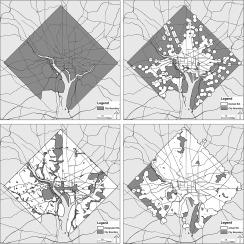Journal of Transport Geography ( IF 5.7 ) Pub Date : 2021-09-03 , DOI: 10.1016/j.jtrangeo.2021.103185 Si'an Meng 1 , Anne Brown 1

|
Docked bike-share programs have proliferated worldwide, but studies find that the distribution of docked stations is geographically unequal. New dockless systems offer more flexibility compared to docked systems, but it remains unclear if dockless systems can address existing geographic inequities. This study examines all 32 US cities with both docked and dockless micromobility (bikeshare and e-scooter) programs and develops three service geography indicators to compare the geographic equity of docked versus dockless systems. We first use Lorenz curves and Gini indices to examine the overall spatial distribution of micromobility; we then use logistic and Tobit regressions to investigate how service geography corresponds to neighborhood characteristics. Results show that the distribution of docked systems is extremely unequal, and that dockless systems greatly reduce geographical inequalities relative to docked. Low-density areas and neighborhoods with low median household incomes, smaller shares of young people, and fewer zero-car households have limited micromobility service. Docked services are less prevalent in communities of color, and the implementation of dockless systems yields mixed outcomes for racial equity. Importantly, designated service areas do not always translate into available micromobility vehicles. Policymakers should use program design and performance metrics to address the mismatch between designated and actual service geographies and to ensure that micromobility services benefit marginalized communities.
中文翻译:

停靠与无停靠股权:比较三个微移动服务地域
停靠共享单车项目在全球范围内激增,但研究发现停靠站点的分布在地理上是不平等的。与停靠系统相比,新的无停靠系统提供了更大的灵活性,但目前尚不清楚无停靠系统是否可以解决现有的地理不平等问题。本研究调查了所有 32 个美国城市同时拥有停靠和无停靠微型移动(共享单车和电动滑板车)计划,并开发了三个服务地理指标来比较停靠和无停靠系统的地理公平性。我们首先使用洛伦兹曲线和基尼指数来检验微流动性的整体空间分布;然后我们使用逻辑回归和 Tobit 回归来研究服务地理如何对应于邻域特征。结果表明对接系统的分布极不均匀,并且无坞站系统大大减少了相对于有坞站的地理不平等。低密度地区和家庭收入中位数较低、年轻人比例较小以及零汽车家庭较少的社区,其微型交通服务有限。停靠服务在有色人种社区中不那么普遍,而且无停靠系统的实施对种族平等产生了不同的结果。重要的是,指定的服务区并不总能转化为可用的微型交通工具。政策制定者应使用计划设计和绩效指标来解决指定和实际服务地域之间的不匹配问题,并确保微型交通服务使边缘化社区受益。年轻人所占比例较小,零汽车家庭较少,微型交通服务有限。停靠服务在有色人种社区中不那么普遍,而且无停靠系统的实施对种族平等产生了不同的结果。重要的是,指定的服务区并不总能转化为可用的微型交通工具。政策制定者应使用计划设计和绩效指标来解决指定和实际服务地域之间的不匹配问题,并确保微型交通服务使边缘化社区受益。年轻人所占比例较小,零汽车家庭较少,微型交通服务有限。停靠服务在有色人种社区中不那么普遍,而且无停靠系统的实施对种族平等产生了不同的结果。重要的是,指定的服务区并不总能转化为可用的微型交通工具。政策制定者应使用计划设计和绩效指标来解决指定和实际服务地域之间的不匹配问题,并确保微型交通服务使边缘化社区受益。指定的服务区并不总能转化为可用的微型交通工具。政策制定者应使用计划设计和绩效指标来解决指定和实际服务地域之间的不匹配问题,并确保微型交通服务惠及边缘化社区。指定的服务区并不总能转化为可用的微型交通工具。政策制定者应使用计划设计和绩效指标来解决指定和实际服务地域之间的不匹配问题,并确保微型交通服务惠及边缘化社区。











































 京公网安备 11010802027423号
京公网安备 11010802027423号